Hippobromus pauciflorus
Hippobromus pauciflorus (L.f.) Radlk.
Family: Sapindaceae
Common names: false horsewood, bastard horsewood (Eng.); valsperdepis, basterperdepis boom, basterperdepis (Afr.); isiphahluka, uqhume, umnungumabele, umfazothethayo (isiZulu); isiphahluka, luphephetse (siSwati); ulwatile, isifutha, umfazi-onengcolo, ulabateka, umnukambiba (isiXhosa); mufhapabere (Tshivenda)
SA Tree No: 438
Introduction
A small to medium sized, attractive, fast-growing tree with a dense rounded crown of shiny, aromatic leaves, clusters of small creamy white, scented flowers in spring and summer, and berry-like fruits.
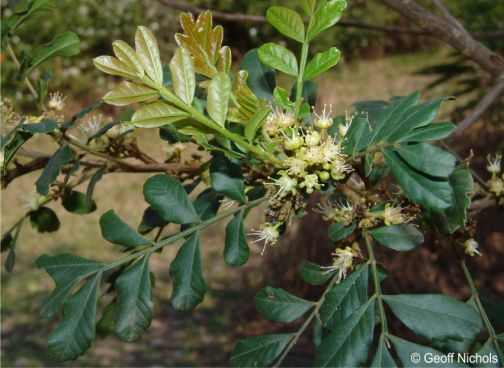
Description
Description
Hippobromus pauciflorus is a semi-deciduous to evergreen tree of up to 9 m tall, often multi-stemmed or with a single stem. The stem is slender with many spreading branches. Immature stems are greyish-brown with a dense layer of fine, velvety hairs which fade as they mature. Bark is dark grey-brown with narrow, long cracks, with reddish to yellow colour under the bark showing through the cracks. Leaves are alternate and compound with 3-6 pairs of leaflets, sub opposite, nearly sessile, glossy dark green above and paler below, with thinly leathery texture. Leaflets are obovate and variable in shape, winged on the rachis between leaflets and they tend to overlap. The midrib is visible on both sides of the leaves and the margin is slightly dentate, entire or deeply lobed. New leaves are shiny, reddish to brownish and produce a resinous smell when crushed. Flowers are small, scented, creamy-white, often tinged with red. They arise in golden, velvety buds, borne in clusters up to 20 mm wide, in the axils of the leaves, from midwinter to midsummer (July to January). Fruits are small, red, glossy, globose, fleshy, berry-like drupes, from spring to autumn (September to March). They turn black when they are ripe and are edible, but the pulp is distasteful.
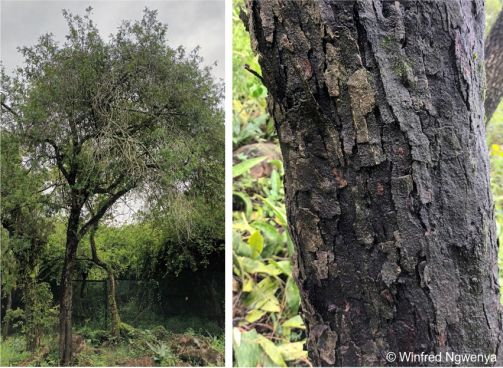
Hippobromus pauciflorus can be confused with Clausena anisata, the difference is that the new leaves of the Hippobromus pauciflorus plants are reddish to brownish, whereas the new leaves of Clausena anisata are dark green and produce a strong offensive odour when bruised. All parts of the Hippobromus tree emit a balmy aromatic scent when handled.
Conservation Status
Status
According to the SANBI Red List of South African plants, Hippobromus pauciflorus is a widepread species that is not threatened and is thus assessed as Least Concern (LC).
Distribution and habitat
Distribution description
Hippobromus pauciflorus is distributed in northern and eastern South Africa, Eswatini and in southern Mozambique. In South Africa it occurs in the Eastern Cape, KwaZulu-Natal, Mpumalanga, Limpopo and Gauteng Provinces. It occurs on forested ridges, on forest margins, along rivers and on stream banks, in scrub forest, on rocky slopes and outcrops, in bushveld, riverine thicket and occasionally in grassland. This plant species grows in a warm, moist subtropical region with good summer rainfall and prefers moist conditions but not wet conditions. It grows very well in full sun or semi-shade. Hippobromus pauciflorus is a hardy plant that can survive periods of drought, and it can withstand a fair amount of cold, even occasional frost. This plant species is resistant to strong wind and has a self-supporting growth form.
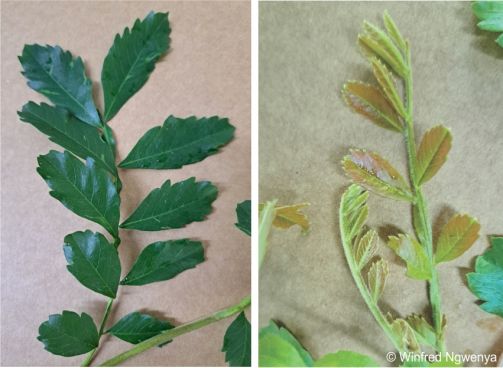
Derivation of name and historical aspects
History
Hippobromus pauciflorus belongs to the Sapindaceae, known as the soapberry family, a family of 138 genera and 1858 accepted species that occur in temperate to tropical regions. Members of this family contain latex, a milky sap, and many mildly toxic saponins with soap-like qualities in either the foliage, the seeds or the roots. Sapindaceae contains many members that are of high economic importance, prized for their fruits, timber, ornamental properties and extracts which are used as additives in detergents and cosmetics. Well know members include Litchi, maple (Acer) and horse chestnut (Aesculus).
The genus name is derived from the Greek words Hippos, meaning ‘horse’ and bromos meaning ‘stench’, and refers to the smell of the leaves which is thought to resemble horse urine, perdepis in Afrikaans, or it is so named because it looks similar to the true perdepis, Clausena anisata, and at one time they were both called perdepis and the botanists Ecklon and Zeyher, who named this genus in 1836, knew it by that name. The specific epithet pauciflorus is a Latin word meaning ‘few-flowered’.
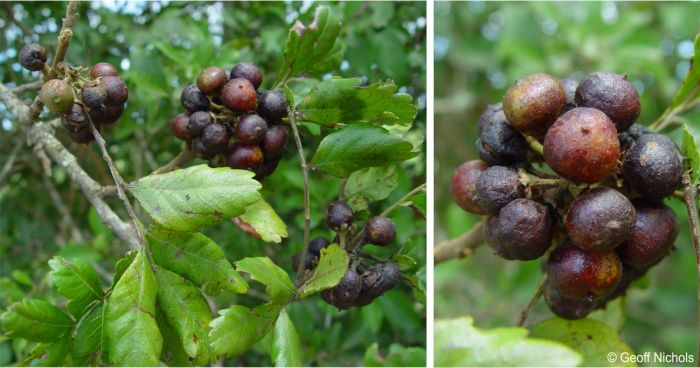
Ecology
Ecology
Hippobromus pauciflorus is a much favoured larval food plant of the Citrus Swallowtail butterfly (Papilio demodocus) as well as for charaxes (Charaxinae), nymph and commodore (Nymphalinae) and blue and copper (Lycaenidae) butterflies. Flowers of this plant species attract bees, wasps and beetles. Bees are the main pollinators of Hippobromus pauciflorus flowers. When the plant is in flower or has fruits, it also attracts birds that eat insects, fruits and seeds. Seeds are dispersed by birds.
Leaves and bark are browsed by many game animals, including Black Rhino.
The wood and leaves contain a strongly scented resinous and oily substance which makes the plant readily inflammable.

Uses
Use
Hippobromus pauciflorus has been used in traditional medicine to treat many different human and animal diseases. Headache is treated by inhaling the vapour from the crushed leaves. Juice extracted from the leaves is used to treat inflamed and infected eyes. A concoction of the roots is used to treat dysentry and diarrhoea. Liquid extracted from the roots is used to induce vomiting. Leaves are mixed with boiling water and the steam is used to chase away bad spirits. It is also used as a love charm and to treat stock (goats and sheep) suffering from cough. Seeds lathered in water are used as soap. Caution is advised when using extracts from roots and leaves of the Hippobromus pauciflorus plant because it is poisonous.
The hard, strong wood is used to make wagons, to build huts, to make walking sticks and fence posts.
This plant species is suitable for smaller gardens due to its small structure, however, it should not be planted near paving or buildings or the braai (barbecue) area. In horticulture, this plant species can be used to provide shade due to its dense foliage, as a hedge, for screening, as a filler, as a windbreaker and as ornamental plant. It will also attract birds, butterflies and bees to the garden.
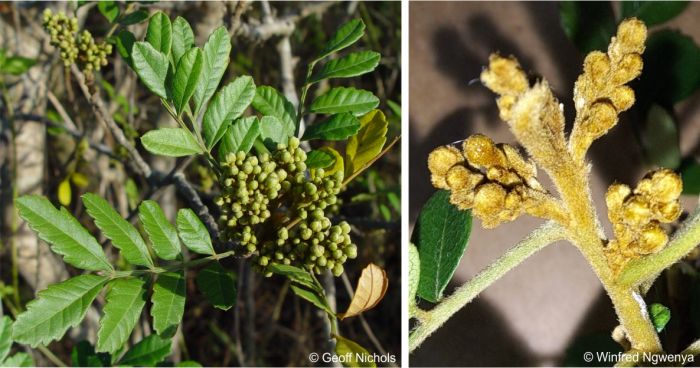
Growing Hippobromus pauciflorus
Grow
Hippobromus pauciflorus can be easily propagated by seeds. Collect the seeds when the fruits are black, clean the seeds by removing the flesh by hand. Sow the seeds in spring or summer when they are still fresh, in a mixture of potting soil and washed river sand. Place the seed tray under a shade net and not in direct sunlight. Water the seeds three times per week using overhead sprinklers. The seeds take about 3 to 4 weeks to germinate.
Before transplanting the seedlings in to individual pots, it is better to harden them off because outdoor conditions are more harsh than those in the sheltered nursery environment. Gradually expose the seedlings to outdoor conditions for 7 to 14 days before transplanting to avoid damage and failure to thrive. Water the seedlings, prick them out using a wooden stick, when they have two leaves or are 10 cm long. Handle them gently to avoid damage. Roots of the seedlings should be covered completely. Place the seedlings under a shade net and water them twice a week.

This plant species is fast-growing, resistant to wind and grows in moist tropical or subtropical regions with rain in summer. It prefers a position in full sun or semi-shade. It is prefers a well-drained, nutrient rich loam or peat soil, but will also do well in a sandy soil with a slightly acidic to neutral pH. Give the plants more water in hot, dry weather and less water in winter. If planted in a nutrient-poor soil, compost and organic fertilizer should be added as well as a layer of mulch to retain the moisture during very dry periods. The root system can quickly become invasive, so it is not advisable to plant it too close to pools, paving, walls and other permanent structures. Pruning should be done in early spring (August) to remove the small twigs around the main stem, to give the plant a pleasing and neat shape.
In warmer areas Hippobromus pauciflorus remains evergreen, and can be used in the garden to provide shade and to attract birds and insects. This plant species is good for screening, in a mixed shrub border, as a windbreaker and to be used for ornamental purposes. It is also suitable for coastal gardens. Plant species like Pappea capensis and Catha edulis will be found in the same habitat with Hippobromus pauciflorus because they share same requirements. This plant species can become invasive, appropriate action should be taken to remove seedlings and suckers.
Larvae of the a number of butterflies feed on the leaves, pesticides should be used to control pests as and when they arise.
References
- Boon, R. 2010. Pooley's trees of eastern South Africa, a complete guide. Flora & Fauna Publications Trust, Durban.
- CJM growers. Hippobromus pauciflorus. https://cjmgrowers.co.za/hippobromus-pauciflorus/. Accessed on 6/12/2023.
- Grow Wild. Hippobromus pauciflorus. https://growwild.co.za/product/hippobromus-pauciflorus/. Accessed on 6/12/2023.
- Schmidt, E., Lötter, M. & McCleland, W. 2002. Trees and shrubs of Mpumalanga and Kruger National Park. Jacana, Johannesburg.
- Smith, C.A. 1966. Common names of South African plants. Memoirs of the Botanical Survey of South Africa No. 35. Government Printer, Pretoria.
- Von Staden, L. & Van Wyk, A.E. 2018. Hippobromus pauciflorus (L.f.) Radlk. National Assessment: Red List of South African Plants version 2020.1. Accessed on 2024/01/04.
- Wikipedia. Hippobromus pauciflorus. https://en.wikipedia.org/wiki/Hippobromus_pauciflorus. Accessed on 4/12/2023.
- Wikipedia. Sapindaceae. https://en.wikipedia.org/wiki/Sapindaceae. Accessed on 4/12/2023.
Credits
Winfred Ngwenya
Lowveld National Botanical Garden
January 2024
Acknowledgements: some of the images are by Geoff Nichols
Plant Attributes:
Plant Type: Shrub, Tree
SA Distribution: Eastern Cape, KwaZulu-Natal, Limpopo, Mpumalanga
Soil type: Sandy, Loam
Flowering season: Spring, Early Summer, Winter
PH: Acid, Neutral
Flower colour: White, Cream
Aspect: Full Sun, Morning Sun (Semi Shade), Afternoon Sun (Semi Shade)
Gardening skill: Easy
Special Features:
Horticultural zones








Rate this article
Article well written and informative
Rate this plant
Is this an interesting plant?
Login to add your Comment
Back to topNot registered yet? Click here to register.